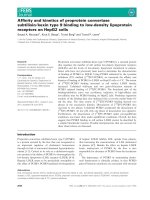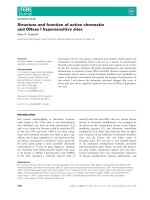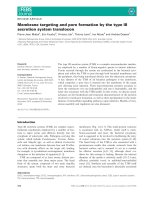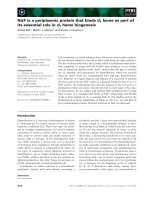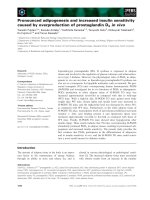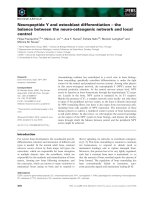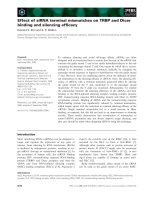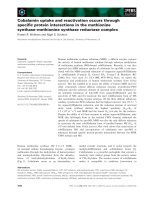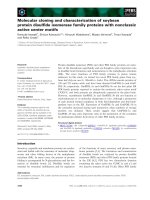Tài liệu Báo cáo khoa học: Structure determination and biochemical studies on Bacillus stearothermophilus E53Q serine hydroxymethyltransferase and its complexes provide insights on function and enzyme memory doc
Bạn đang xem bản rút gọn của tài liệu. Xem và tải ngay bản đầy đủ của tài liệu tại đây (874.04 KB, 13 trang )
Structure determination and biochemical studies
on Bacillus stearothermophilus E53Q serine
hydroxymethyltransferase and its complexes provide
insights on function and enzyme memory
V. Rajaram
1
*, B. S. Bhavani
3
*, Purnima Kaul
3
, V. Prakash
3
, N. Appaji Rao
2
, H. S. Savithri
2
and
M. R. N. Murthy
1
1 Molecular Biophysics Unit, Indian Institute of Science, Bangalore, India
2 Department of Biochemistry, Indian Institute of Science, Bangalore, India
3 Department of Protein Chemistry and Technology, Central Food Technological Research Institute, Mysore, India
Keywords
crystal structure; enzyme memory;
pyridoxal 5¢-phosphate; SHMT
Correspondence
M. R. N. Murthy, Molecular Biophysics Unit,
Indian Institute of Science, Bangalore
560 012, India
Fax: +91 80 2360 0535
Tel: +91 80 2293 2458
E-mail:
*These authors contributed equally to this
work
(Received 4 March 2007, revised 6 May
2007, accepted 14 June 2007)
doi:10.1111/j.1742-4658.2007.05943.x
Serine hydroxymethyltransferase (SHMT) belongs to the a-family of
pyridoxal 5¢-phosphate-dependent enzymes and catalyzes the reversible
conversion of l-Ser and tetrahydrofolate to Gly and 5,10-methylene
tetrahydrofolate. 5,10-Methylene tetrahydrofolate serves as a source of
one-carbon fragment in many biological processes. SHMT also catalyzes
the tetrahydrofolate-independent conversion of l-allo-Thr to Gly and
acetaldehyde. The crystal structure of Bacillus stearothermophilus SHMT
(bsSHMT) suggested that E53 interacts with the substrate, l-Ser and tetra-
hydrofolate. To elucidate the role of E53, it was mutated to Q and struc-
tural and biochemical studies were carried out with the mutant enzyme.
The internal aldimine structure of E53QbsSHMT was similar to that of the
wild-type enzyme, except for significant changes at Q53, Y60 and Y61. The
carboxyl of Gly and side chain of l-Ser were in two conformations in
the respective external aldimine structures. The mutant enzyme was com-
pletely inactive for tetrahydrofolate-dependent cleavage of l-Ser, whereas
there was a 1.5-fold increase in the rate of tetrahydrofolate-independent
reaction with l-allo-Thr. The results obtained from these studies suggest
that E53 plays an essential role in tetrahydrofolate ⁄ 5-formyl tetrahydro-
folate binding and in the proper positioning of Cb of l-Ser for direct
attack by N5 of tetrahydrofolate. Most interestingly, the structure of the
complex obtained by cocrystallization of E53QbsSHMT with Gly and
5-formyl tetrahydrofolate revealed the gem-diamine form of pyridoxal
5¢-phosphate bound to Gly and active site Lys. However, density for
5-formyl tetrahydrofolate was not observed. Gly carboxylate was in a sin-
gle conformation, whereas pyridoxal 5¢-phosphate had two distinct confor-
mations. The differences between the structures of this complex and Gly
external aldimine suggest that the changes induced by initial binding of
5-formyl tetrahydrofolate are retained even though 5-formyl tetrahydro-
folate is absent in the final structure. Spectral studies carried out with this
mutant enzyme also suggest that 5-formyl tetrahydrofolate binds to the
E53QbsSHMT-Gly complex forming a quinonoid intermediate and falls off
Abbreviations
bsSHMT, Bacillus stearothermophilus SHMT; CD, circular dichroic; eSHMT, Escherichia coli SHMT; FTHF, 5-formyl THF; IPTG, isopropyl thio-
b-
D-galactoside; mcSHMT, murine cytosolic SHMT; LB, Luria–Bertani; PLP, pyridoxal 5¢-phosphate; rcSHMT, rabbit liver cytosolic SHMT;
scSHMT, sheep liver cytosolic SHMT; SHMT, serine hydroxymethyltransferase; THF, tetrahydrofolate.
4148 FEBS Journal 274 (2007) 4148–4160 ª 2007 The Authors Journal compilation ª 2007 FEBS
Serine hydroxymethyltransferase (SHMT) is a member
of the a-family of pyridoxal 5¢-phosphate (PLP)-depen-
dent enzymes [1]. It catalyzes the reversible intercon-
version of l-Ser and tetrahydrofolate (THF) to Gly
and 5,10-methylene THF (5,10-CH
2
THF). This com-
pound serves as a key intermediate in the biosynthesis
of methionine, thymidylate, purines, formyl t-RNA
and a variety of other end products that require one-
carbon fragments for their synthesis [2]. Increase in the
activity of SHMT along with enhanced DNA synthesis
in neoplastic tissues has suggested that SHMT might
be a target for cancer chemotherapy [3]. In addition to
its physiological reaction, SHMT catalyses the aldol
cleavage of a number of b-hydroxy amino acids such
as l-Thr, l-allo-Thr, l-threo- and l-erythro-b-phenyl
serine [4–6]. It also catalyzes transamination, racemiza-
tion and decarboxylation reactions [7].
SHMT has been isolated and studied from several
sources. X-ray crystal structures of SHMT from
human liver (hc) [8], murine (mc) [9], rabbit liver (rc)
[10], Escherichia coli (e) [11] and Bacillus stearothermo-
philus (bs) [12] have been determined. The enzyme
from prokaryotes is a dimer, whereas that from
eukaryotic organisms is a dimer of tight dimers. It was
suggested that SHMT cleaves l-Ser to Gly and formal-
dehyde by a retroaldol mechanism, in which the cleav-
age is initiated by abstraction of the hydroxy proton
of l-Ser by a base at the active site. The formaldehyde
generated interacts with THF to form 5,10-CH
2
THF,
which is released from the active site. Gly dissociates
from the active site in a rate-determining step to com-
plete the catalytic cycle [13]. Of the two groups that
could serve as bases for abstracting proton (E53 and
H122 in bsSHMT), E53 was present in its protonated
form in the crystal structure, suggesting that it could
not be involved in the proton abstraction step of catal-
ysis [11,12]. Mutation of the other residue, H147 in
scSHMT corresponding to H122 in bsSHMT, led only
to a partial loss of enzyme activity, indicating that it
could not be the residue abstracting the proton [14].
In addition, to abstract the proton from CH
2
OH
of l-Ser, an antiperiplanar geometry of the atoms
involved in the electron movement is required. How-
ever, the crystal structure of serine external aldimine of
bsSHMT suggests that the geometry is not optimal for
retroaldol cleavage. Therefore, a direct transfer mecha-
nism was suggested for the reaction catalyzed by
SHMT [12]. This proposal envisages direct nucleophilic
attack on the Cb carbon of l-Ser by N5 of THF lead-
ing to the formation of a covalent adduct of THF and
serine. In their revised mechanism, Szebenyi et al. [15]
also proposed that there is a direct nucleophilic attack
by N5 of THF on Cb of l-Ser leading to Ca–Cb bond
cleavage to form 5,10-CH
2
THF and glycine bound
anion. It was noted that, in the reverse reaction, the
N5 atom of THF is not optimally positioned for S
N
2
nucleophilic substitution of the serine hydroxyl. To
resolve these difficulties, Szebenyi et al. [15] determined
the structures of E75Q and E75L mutants of rcSHMT
and studied their properties. However, the structures
determined by them were not at high resolution and
suffered from a lack of order in the bound amino acids
[15]. In an effort to resolve this ambiguity, we deter-
mined the structure of E53QbsSHMT and its binary
complexes with Gly, l-Ser, l-allo-Thr and ternary
complex with Gly and 5-formyl-THF (FTHF). In
addition, the biochemical and spectral properties of
these complexes were examined. Mutation of E53 to Q
weakens the binding of THF ⁄ FTHF to the Gly binary
complex. The results highlight the role of E53 in bind-
ing of THF ⁄ FTHF and in the proper positioning of
l-Ser for direct attack by N5 of THF.
The structure of E53QbsSHMT in the presence of
Gly and FTHF shows changes in the position of the
active site residues that are reminiscent of FTHF
binding to bsSHMT even though electron density for
FTHF was not traceable. The differences in the struc-
ture of the E53QbsSHMT-Gly binary complex and
the structure obtained in the presence of Gly and
FTHF provide direct evidence to suggest that the
complex retains the orientation of PLP (gem-dia-
mine), which was seen in the crystal structure of
bsSHMT-Gly-FTHF ternary complex even in the
absence of bound FTHF [12]. This is an example of
‘enzyme memory’ seen for the first time in crystal
structure.
Results and Discussion
E53QbsSHMT internal aldimine
The overall structure of E53QbsSHMT internal aldi-
mine is very similar to that of bsSHMT. The rmsd of
the corresponding Ca atoms upon superposition of the
within 4 h of dialysis, leaving behind the mutant enzyme in the gem-
diamine form. This is the first report to provide direct evidence for enzyme
memory based on the crystal structure of enzyme complexes.
V. Rajaram et al. Crystal structure of E53QbsSHMT and its complexes
FEBS Journal 274 (2007) 4148–4160 ª 2007 The Authors Journal compilation ª 2007 FEBS 4149
wild-type and mutant structures is 0.10 A
˚
. The orienta-
tion of PLP in E53QbsSHMT is identical to that of
bsSHMT [12]. The most obvious differences are seen
in and around the mutated residue E53. The side chain
of Q53 in E53QbsSHMT is in a different conformation
compared to that of E53 in bsSHMT. Changes are
also observed in two adjacent Tyr residues 60 and 61.
The plane of phenyl ring of Y60 in E53QbsSHMT is
almost perpendicular to that observed in bsSHMT. In
comparison, the shift is less in the case of Y61
(approximately 18°) (Fig. 1). The absorption spectrum
of E53QbsSHMT shows a k
max
at 425 nm similar to
that of bsSHMT [16].
E53QbsSHMT-Gly external aldimine
In the Gly and Ser external aldimine complexes of
E75Q and E75LrcSHMT, the electron density for
the ligands was not well defined [15]. In contrast, excel-
lent electron density was observed for the ligands
in E53QbsSHMT. The Gly external aldimine of
E53QbsSHMT (E53QbsSHMT-Gly) shows rmsd
of 0.14 A
˚
with respect to Gly external aldimine of
bsSHMT (bsSHMT-Gly) considering all Ca atoms for
superposition. The side chain conformation of Q53 in
E53QbsSHMT-Gly is only marginally different from
that seen for E53 in bsSHMT-Gly. Unlike in the inter-
nal aldimine, smaller differences are observed in the
conformation of the residues Y60 and Y61. In
bsSHMT-Gly, the plane of the PLP ring is rotated by
24 ° compared to internal aldimine; an identical change
in orientation of PLP was observed in the case of
E53QbsSHMT-Gly.
The most significant difference in the structure is
observed in the case of the bound Gly. The carboxyl-
ate group of Gly is in two distinct conformations in
E53QbsSHMT-Gly. In one conformation, the carbox-
ylate group forms hydrogen bonds with R357, as in
bsSHMT-Gly [12]. In the second conformation, the
carboxylate forms hydrogen bonds with NE2 of
Q53 (3.34 A
˚
) and NE2 of H122 (3.32 A
˚
). This second
conformation has an occupancy of 0.4. When the
carboxylate is in the conformation found more pre-
dominantly (i.e. towards R357), a water molecule with
an occupancy of 0.6 is present close to the position
corresponding to the second conformation of the
carboxylate group (Fig. 2A,B). The hydrogen bonding
between Q53 and the second conformation of carbo-
xylate of Gly found in E53QbsSHMT-Gly is less likely
to occur in the wild-type enzyme. The water molecule
with partial occupancy is stabilized by its interaction
with OG of S172 (3.2 A
˚
) and another water molecule
(2.76 A
˚
). Apart from the above differences, there is
also a small movement (0.2–0.4 A
˚
) of the main chain
in the region 385–394. This region is solvent exposed
and is not near the active site or near the site of
mutation.
E53QbsSHMT in presence of Gly and FTHF
Addition of Gly to the mutant enzyme showed a small
decrease in the absorption at 425 nm and a corre-
sponding increase at 495 nm, indicating the presence
of small amount of quinonoid intermediate. The for-
mation of the quinonoid intermediate requires abstrac-
tion of a proton from the a-carbon atom of the bound
Fig. 1. Conformation of residues Y51, E53,
Y60, Y61 and Schiff base (PLP covalently
linked to K226) in E53QbsSHMT mutant
(Yellow) with respect to bsSHMT (Blue).
Y51 and the Schiff base are in the same ori-
entation in E53QbsSHMT and bsSHMT,
whereas the orientations of E53, Y60 and
Y61 have changed.
Crystal structure of E53QbsSHMT and its complexes V. Rajaram et al.
4150 FEBS Journal 274 (2007) 4148–4160 ª 2007 The Authors Journal compilation ª 2007 FEBS
Gly. Further addition of THF or FTHF increased the
absorbance significantly at 495 nm and 500 nm,
respectively (Fig. 3), suggesting conversion of a signifi-
cant fraction of the enzyme to the quinonoid form. A
similar observation has been made with the wild-type
enzyme [16].
Intriguing results are obtained with the structure of
the mutant enzyme determined in the presence of Gly
and FTHF [E53QbsSHMT-Gly(FTHF)] In the wild-
type enzyme, these ligands form a ternary complex
(bsSHMT-Gly-FTHF). In contrast to the orthorhom-
bic space group with a monomer in the asymmetric
unit of bsSHMT internal and external aldimines, the
ternary complex crystallizes in a monoclinic cell with
b angle very close to 90° and a dimer in the asymmet-
ric unit due to asymmetric binding of FTHF to the
two subunits, which leads to breakdown of the two-
fold symmetry and hence to the monoclinic crystal
form [12]. Attempts to crystallize E53QbsSHMT in the
presence of Gly and FTHF yielded orthorhombic crys-
tals and the density for FTHF could not be traced.
PLP in this complex was trapped in a gem-diamine
form covalently bonded to both the active site lysine
and the added Gly amino group (Fig. 4A). Gem-diamine
is an intermediate formed in the interconversion of
the enzyme between internal and external aldimine
forms. The orientation of PLP in E53QbsSHMT-
Gly(FTHF) complex is closer to that of bsSHMT-Gly-
FTHF than its orientation in the internal or external
aldimine structures of mutant or wild-type enzymes.
This is consistent with the earlier observation that the
orientation of PLP in the ternary complex of
mcSHMT [9] is similar to the PLP in the gem-diamine
form. However, the present structure does not contain
density for FTHF. The similarity in the orientation of
PLP to that of the wild-type ternary complex [12] and
absence of FTHF in the crystal structure suggests that
there is an initial binding of FTHF leading to an alter-
ation in the orientation of PLP and, subsequently,
FTHF falls off from the active site. The differences
between the structures of this complex and Gly exter-
nal aldimine suggest that the changes induced by initial
binding of FTHF are retained, even though FTHF is
absent from the final structure.
Another interesting observation in the structure of
E53QbsSHMT-Gly(FTHF) is that the phosphate
group of PLP is in two conformations (Fig. 4A,B).
The interactions in the first conformation are similar
to those described for the bsSHMT-Gly-FTHF [12].
The second conformation is stabilized mainly by
hydrogen bonding to atoms from the symmetry related
subunit. One of the phosphate oxygen atoms in this
Fig. 3. Time course of disappearance of quinonoid intermediate in
E53QbsSHMT. The spectrum of bsSHMT-Gly-FTHF (1 mgÆmL
)1
enzyme, 50 mM Gly, 500 lM FTHF) and E53QbsSHMT-Gly(FTHF)
had absorbance maximum at 500 nm, suggesting the presence
of quinonoid intermediate (–). Spectra recorded after (d)1,(j)2
and (m) 3 h of dialysis, respectively. A significant decrease was
observed in the quinonoid intermediate peak (500 nm) with con-
comitant appearance of a peak at 425 nm (m). bsSHMT quino-
noid intermediate peak at 500 nm was unchanged after dialysis
for 4 h (–).
A
B
Fig. 2. (A) Stereo diagram illustrating electron density (omit map)
corresponding to PLP and Gly in E53QbsSHMT-Gly. The two
conformations of Gly are shown. A water molecule is present
close to the second conformation of Gly with an occupancy of
0.6. (B) Stereo diagram showing the interactions (dotted lines) of
carboxyl group of Gly with other residues in the E53QbsSHMT-
Gly complex.
V. Rajaram et al. Crystal structure of E53QbsSHMT and its complexes
FEBS Journal 274 (2007) 4148–4160 ª 2007 The Authors Journal compilation ª 2007 FEBS 4151
conformation is held by hydrogen bonding interaction
with the phenolate oxygen of Y51, N of G257 and
NE2 of Q53 of the symmetry related subunit. Another
oxygen atom is held by hydrogen bonding to NE2 of
H122 and phenolate oxygen of Y51 of the symmetry
related subunit. The third oxygen is hydrogen bonded
to a water molecule and NE2 of H122. The new posi-
tion of the phosphate group induces a displacement in
Y51. As Y51 moves to the position occupied earlier by
Y61, a corresponding movement is also found in Y61
(Fig. 4B). In all other complexes of E53QbsSHMT,
OH of Y51 interacts with OP2 of PLP (Fig. 4B,C). As
the orientation of Y51 is different in this complex, a
water molecule compensates for this interaction. There
are also small main chain movements in the regions
83–87, 237–244, 255–258 and 385–394. Most of these
regions are solvent exposed and are not directly related
to the active site or site of mutation. The overall struc-
ture (other than the changes described above) of
E53QbsSHMT-Gly(FTHF) matches better with
bsSHMT-Gly (rmsd ¼ 0.15 A
˚
) than with the A or B
subunits of bsSHMT-Gly-FTHF with which it has
rmsd of 0.41 and 0.44 A
˚
, respectively.
Upon the addition of FTHF to the binary complex
of E53QbsSHMT-Gly, the color of the solution chan-
ged from yellow to pink, indicating the formation of a
quinonoid intermediate. However by the time crystals
were formed, the color of the drop had turned yellow,
suggesting the conversion of the quinonoid intermedi-
ate to other forms of the enzyme. Crystallographic
results suggest that the final state of the enzyme is
influenced by the initial binding of FTHF and differs
significantly from the binary complex formed in the
absence of FTHF.
Spectroscopic observations also suggest that FTHF
dissociates from the enzyme upon prolonged storage
(12 h). The rate of formation of the quinonoid inter-
mediate upon addition of THF to the mutant enzyme-
Gly complex was 2.2 s
)1
as determined by stopped
flow kinetics, compared to 340 s
)1
for bsSHMT. It can
be recalled that the formyl oxygen group of FTHF
interacts with E53 in bsSHMT-Gly-FTHF ternary
complex [12]. Both bsSHMT and E53QbsSHMT ter-
nary complexes were dialyzed against buffer (50 mm
potassium phosphate pH 7.4 containing 1 mm EDTA
and 1 mm 2-mercaptoethanol) devoid of Gly and
FTHF and spectra were recorded at intervals of 1 h.
Significant decrease was observed in the quinonoid
intermediate peak (500 nm) with concomitant appear-
ance of a peak at 425 nm (Fig. 3) at the end of 4 h,
suggesting that FTHF had dissociated from the com-
plex and distribution of the intermediates was altered
in the case of the E53QbsSHMT ternary complex. On
the other hand, the bsSHMT quinonoid intermediate
peak at 500 nm did not change after dialyzing for 4 h
(Fig. 3). PLP was estimated in the dialyzed sample and
it was found that the amount (1 mol of PLP per mol
A
B
C
Fig. 4. (A) Electron density (omit map) showing gem-diamine in
E53QbsSHMT-Gly-FTHF complex. (B) Superposition of residues
Y51, E53, Y60 and PLP in E53QbsSHMT-Gly(FTHF) (yellow) and
E53QbsSHMT-Gly (brown). (C) Superposition of residues Y51, E53,
Y60 and PLP in E53QbsSHMT-Gly(FTHF) (yellow) and bsSHMT-Gly-
FTHF (blue).
Crystal structure of E53QbsSHMT and its complexes V. Rajaram et al.
4152 FEBS Journal 274 (2007) 4148–4160 ª 2007 The Authors Journal compilation ª 2007 FEBS
of subunit) was the same in both bsSHMT and
E53QbsSHMT. The dissociation constant (K
d
)of
FTHF for E53QbsSHMT-Gly was determined from
double reciprocal plots of the change in the absor-
bance at 500 nm versus FTHF concentration at differ-
ent fixed concentrations of Gly. A replot of the
Y intercept versus concentration of Gly gave the K
d
values for FTHF. A similar experimental approach
was used to determine the K
d
in the case of rcSHMT
[17]. The K
d
value for E53QbsSHMT-Gly was 25 lm
compared to 10 lm for bsSHMT-Gly. The 2.5-fold
higher K
d
further suggests that the affinity of
E53QbsSHMT-Gly for FTHF is reduced. Although
the density for FTHF is not seen in E53QbsSHMT-
Gly(FTHF), the orientation of PLP (gem-diamine
form) in this complex is very similar to that of
wild-type ternary complex [12]. The circular dichroic
(CD) spectrum of E53QbsSHMT in the presence of
Gly and FTHF showed a band at 343 nm (Fig. 5),
suggesting the presence of the gem-diamine form
of E53QbsSHMT. The crystal structure of E53Q-
Gly(FTHF) also showed that PLP is indeed in the
gem-diamine form and the FTHF is not bound
(Fig. 4A). This is an interesting case of ‘enzyme mem-
ory’. One of the important kinetic evidences for the
occurrence of enzyme memory is the demonstration of
significant variation of acceptor double reciprocal
slopes with variation in donor substrate. In the
case of ascorbate oxidase, changes in the slope in
the double reciprocal plot with three different donor
substrate have been used to demonstrate enzyme
memory [18]. In order to show that indeed
E53QbsSHMT-Gly(FTHF) is kinetically different from
E53QbsSHMT-Gly, we carried out overnight dialysis
of E53QbsSHMT-Gly(FTHF) against the buffer not
containing glycine and FTHF and determined the
slope for the formation of quinonoid intermediate by
the addition of 10 mm glycine and varying FTHF con-
centrations. As shown in Fig. 6 the double reciprocal
plot for the formation of quinonoid intermediate as a
function of FTHF concentration is different for
E53QbsSHMT before and after exposure to glycine
and FTHF. The two forms of enzymes bind to FTHF
with different slopes (before dialysis )104.4; after dial-
ysis )234.1). In contrast, for bsSHMT, slopes were
similar before (21.42) and after dialysis (33.74). If the
lines were parallel then it would suggest that
E53QbsSHMT has no enzyme memory and that the
two forms before and after dialysis are kinetically simi-
lar. However, because the slopes are drastically differ-
ent for E53QbsSHMT, it suggests that the enzyme
conformation previously exposed to glycine and FTHF
is different from that before exposure and that
E53QbsSHMT exhibits enzyme memory. The slow
conformational change seen in the E53QbsSHMT and
not in the bsSHMT enzyme highlights the importance
of glutamate residue in enhanced cleavage of l-Ser in
the presence of THF.
Fig. 5. Visible CD spectra of bsSHMT-Gly-FTHF (1 mgÆmL
)1
enzyme, 50 mM Gly, 500 lM FTHF) and E53QbsSHMT-Gly(FTHF).
The CD spectrum of the ternary complex of the E53QbsSHMT has
significant ellipticity at 343 nm, suggesting the presence of gem-
diamine (d); ternary complex of bsSHMT shows only quinonoid
intermediate (–).
Fig. 6. Double reciprocal plots for the formation of quinonoid inter-
mediate before and after dialysis of E53QbsSHMT-Gly(FTHF). The
enzyme (1 mgÆmL
)1
) was incubated with 10 mM glycine and a vary-
ing concentration of FTHF (0–400 l
M), for 1 min and absorbance at
500 nm was measured. The reciprocal of A
500
was plotted against
the reciprocal of FTHF concentration (j). The enzyme (10 mg) was
incubated with 10 m
M glycine and 500 lM FTHF for 5 min and then
dialyzed against buffer D not containing glycine and FTHF. Such an
enzyme was once again incubated with glycine (10 m
M) and differ-
ent concentrations of FTHF as in (j) and the absorbance was mea-
sured at 500 nm. The double reciprocal plot (1 ⁄ A versus 1 ⁄ [FTHF])
for the dialyzed enzyme is shown (m).
V. Rajaram et al. Crystal structure of E53QbsSHMT and its complexes
FEBS Journal 274 (2007) 4148–4160 ª 2007 The Authors Journal compilation ª 2007 FEBS 4153
It is possible to imagine a series of reasonable
atomic movements that account for the observed dif-
ferences between the complexes of E53QbsSHMT-Gly
obtained in the absence and presence of FTHF. The
carboxylate of Gly is in a single conformation in the
wild-type enzyme in which it is hydrogen bonded to
R357. In contrast, in E53QbsSHMT, it is partitioned
between two positions that allow hydrogen bonding
with Q53 and R357, respectively. Upon FTHF bind-
ing, the Gly carboxylate, which is hydrogen bonded
with E53, is in severe short contact with the aldehyde
group of FTHF and hence is confined to a single posi-
tion that allows bonding with only R357, a situation
similar to the wild-type enzyme. To compensate for
the loss of hydrogen bonding interaction with the car-
boxylate, Q53 pulls the phosphate of PLP into an
alternate position suitable for bonding. These rear-
rangements of atoms probably lead to dissociation of
FTHF. However, the alternate position occupied by
phosphate does not return to its original position,
probably resulting in PLP in the gem-diamine form
(Figs 3Aand 4A) [19–22].
E53QbsSHMT-Ser external aldimine
The structure of E53QbsSHMT complexed with l-Ser
(E53QbsSHMT-Ser) shows an rmsd of 0.11 A
˚
with
respect to that of bsSHMT-Ser. The side chain confor-
mations of Q53 in the mutant and bsSHMT-Ser com-
plexes are similar except for OE1 and NE2 atoms. No
significant changes in the conformation of residues
Y60, Y61 and PLP orientation are observed in the
mutant with respect to bsSHMT-Ser. However, the
side chain hydroxyl of bound serine is in two posi-
tions. The first position is identical to that of
bsSHMT-Ser complex. In the second position, Ser-OG
has a weak hydrogen bonding interaction with OG of
S172 (3.59 A
˚
) and a water molecule (3.46 A
˚
). Apart
from these changes near the active site, a small move-
ment of the main chain is also observed in some sol-
vent exposed regions such as 83–87 (0.2–0.4 A
˚
) and
237–242 (0.4–0.7 A
˚
).
Attempts to obtain crystals of ternary complex of
bsSHMT and E53QbsSHMT in the presence of l-Ser
and FTHF yielded only crystals of l-Ser external aldi-
mine. Earlier attempts to obtain crystals of ternary
complexes of bsSHMT and rcSHMT were also unsuc-
cessful. The reason for this is thought to be the clash
in the position of -CH
2
OH of l-Ser and the formyl
group of FTHF [12].
Mutation of E53 to Q led to a complete loss of
THF-dependent cleavage of l-Ser. (Table 1). K
m
and
V
max
of the mutant enzyme with l-Ser could not be
determined because the activity was barely measurable
even when the protein concentration was increased by
1000-fold. The direct displacement mechanism for
l-Ser cleavage in the presence of THF envisages simul-
taneous attack by the N5 of THF on the Cb of l-Ser
and a proton transfer to the serine hydroxyl group,
leading to the release of a water molecule. E53 in its
protonated state is ideally situated for proton transfer
because the distance of OG of E53 to the OH of l-Ser
is 2.5 A
˚
. Following this cleavage, Gly quinonoid inter-
mediate is formed. The conversion of the Gly quino-
noid intermediate to the external aldimine involves
another protonation step. The Y61 OH group is at a
distance of 2.95 A
˚
from the a-carbon atom of Gly and
appears to be suitable for this proton transfer. As the
internal and external aldimines of SHMTs have simi-
lar visible absorbance spectrum, CD studies were
carried out to examine the formation of external ald-
amine. Addition of l-Ser causes a significant decrease
in the molar ellipticity of bsSHMT at 425 nm (Fig. 7,
Table 1. Kinetic constants for bsSHMT and E53QbsSHMT. Specific
activity is lmol of HCHO min
)1
Æmg
)1
when L-Ser and THF were
used as substrates and lmol of NADH oxidized min
)1Æ
mg
)1
with
L-allo-Thr as substrate.
Enzyme
Specific activity
(
L-Ser) K
m
(mM)
Specific
activity
+ THF – THF
L-Ser L-allo-Thr L-allo-Thr
bsSHMT 5.9 0.8 · 10
)3
0.9 0.8 0.645
E53QbsSHMT 0 1.5 · 10
)3
– 9.5 1.07
Fig. 7. Visible CD spectrum of E53QbsSHMT with L-Ser. The
spectrum was recorded at a protein concentration of 1 mgÆmL
)1
in the range of 300–550 nm (d). Further addition of L-Ser
(50 m
M) to E53QbsSHMT caused a decrease in the ellipticity at
425 nm (–). Inset: Visible CD spectrum of bsSHMT (d) and
bsSHMT with
L-Ser (–).
Crystal structure of E53QbsSHMT and its complexes V. Rajaram et al.
4154 FEBS Journal 274 (2007) 4148–4160 ª 2007 The Authors Journal compilation ª 2007 FEBS
inset). On the other hand, addition of l-Ser to
E53QbsSHMT (Fig. 7) causes only a small change,
suggesting that this external aldimine is spectrally
different from that of the bsSHMT-Ser complex. This
could be due to subtle changes at the active site envi-
ronment upon mutation that result in the binding of
serine with its hydroxyl group in two distinct orien-
tations. It was observed that addition of l-Ser to
bsSHMT caused an increase in thermal melting
temperature (T
m
) from 65 to 80 °C whereas, with the
mutant enzyme, there was no change (72 °C). Addition
of Gly had no effect on the T
m
of either bsSHMT or
E53QbsSHMT. These results suggest that the inter-
actions of l-Ser with bsSHMT and E53QbsSHMT
are significantly different. The results presented so far
suggest that E53 is involved in the proper positioning
of THF ⁄ FTHF and the Cb carbon of serine,
enabling direct nucleophilic attack in the forward
reaction.
E53QbsSHMT and bsSHMT in presence
of
L-allo-threonine
Apart from folate-dependent interconversion of l-Ser
and Gly, SHMT also catalyses the folate-independent
conversion of l-allo-Thr to Gly and acetaldehyde.
Attempts to crystallize bsSHMT and E53QbsSHMT in
the presence of l-allo-Thr yielded crystals with only
Gly bound to PLP. This observation suggested that
l-allo-Thr was completely cleaved to Gly. The density
for acetaldehyde formed in the cleavage was not seen
in the crystal structure. E53QbsSHMT-allo-Thr and
E53QbsSHMT-Gly structures superposed with an
rmsd of 0.11 A
˚
. In E53QbsSHMT-allo-Thr also, gly-
cine carboxylate is in two conformations as in
E53QbsSHMT-Gly. Cleavage of l-allo-Thr to Gly and
acetaldehyde requires several proton transfers. It is
likely that Y61, which undergoes large movements
when the enzyme forms complexes with ligands, is
involved in proton abstraction from the allo-Thr
and ⁄ or the protonation of glycine quinonoid interme-
diate to the external aldimine.
The THF-independent activity with L-allo-Thr as
substrate increased 1.5-fold upon E53Q mutation. It
has been reported that the activity increases by four-
fold in the case of E75QrcSHMT. The K
m
and specific
activity values for l-allo-Thr with bsSHMT were
0.8 mm and 0.65 lmolÆmg
)1
, respectively, and 9.5 mm
and 1.1 lmolÆmg
)1
, respectively, with E53QbsSHMT.
The increase in the activity with l-allo-Thr is consis-
tent with the observation of only Gly bound at the
active site when E53QbsSHMT was cocrystallized with
l-allo-Thr.
Conclusions
The direct transfer mechanism envisages a direct attack
of N5 of THF on the Cb of l-Ser [12]. The role of
E53 is to position the bound amino acid and THF for
such an attack by suitable interactions with other
active site residues. In addition, E53 also interacts with
the formyl oxygen and N10 of FTHF. It is therefore
not surprising that the mutation has affected the
hydrogen-bonding network involving key residues such
as Y60 and Y61 and the interaction with R357, which
anchors the carboxyl group of the substrate. A conse-
quence of these changes is the complete loss of THF-
dependent physiological reaction with l-Ser. However
THF-independent reaction is not reduced. The loss of
interactions of the glutamate residue with the formyl
oxygen and N10 of FTHF in the mutant enzyme
weakens the interactions with THF ⁄ FTHF. Conse-
quently, although a ternary complex is initially formed,
FTHF dissociates and the mutant enzyme crystallizes
in the gem-diamine form. These observations are remi-
niscent of enzyme memory observed in kinetic experi-
ments with plant aspartate synthase, hexokinase and
ascorbate oxidase [18–20]. The results on the formation
of a quinonoid intermediate and gem-diamine complex
and a slow dissociation of FTHF also indicate that
E53QbsSHMT exhibits enzyme memory. This is the
first instance of such a phenomenon observed in struc-
tural studies.
Experimental procedures
Materials
l-[3-
14
C]-Serine, restriction endonucleases and DNA-modi-
fying enzymes were obtained from Amersham Pharmacia
Biotech Ltd (Little Chalfont, UK). Deep Vent Polymerase
was purchased from New England Biolabs (Beverly, MA,
USA). Taq DNA polymerase was purchased from Banga-
lore Genei Pvt. Ltd (Bangalore, India). DEAE-cellulose,
Gly, l-Ser, 2-mercaptoethanol, folic acid, PLP, isopropyl
thio-b-d-galactoside (IPTG) and EDTA were obtained from
Sigma Chemical Co. (St Louis, MO, USA). All other chem-
icals used were of analytical grade.
Bacterial strains and growth conditions
Escherichia coli strain DH5a (BRL) was the recipient for
all the plasmids used in subcloning. The BL21 (DE3) pLysS
[23] strain was used for bacterial expression of pRSH
(B. stearothermophilus SHMT gene cloned and over
expressed in pRSET C vector). Mutant constructs were
similarly overexpressed. Luria–Bertani (LB) medium or
V. Rajaram et al. Crystal structure of E53QbsSHMT and its complexes
FEBS Journal 274 (2007) 4148–4160 ª 2007 The Authors Journal compilation ª 2007 FEBS 4155
terrific broth with 50 lgÆmL
)1
of ampicillin was used for
growing E. coli cells harboring the plasmids [24].
DNA manipulations
Plasmids were prepared by the alkaline lysis procedure [24].
Preparation of competent cells and transformation were
carried out by the method of Alexander [25]. DNA frag-
ments were eluted with QIA quick gel extraction buffer
(Qiagen, Valancia, CA, USA).
E53Q mutant of bsSHMT was constructed using the
primers: E53Q (sense) 5¢-CAAATACGCG
CAAGGCTAT
CCG-3¢ and E53Q (antisense) 5¢-CGGATAGCCT
TGC
GCGTATTTG-3¢. The underlined nucleotides define the
mutation introduced. Primers were used on pRSH template
to construct the mutant by PCR based sense-antisense pri-
mer method [24]. DNA sequencing using an ABI prism
automated DNA sequencer (Applied Biosystems, Foster
City, CA, USA) confirmed presence of the mutation and
showed that no other changes were present.
Expression and purification of bsSHMT and
E53QbsSHMT
The expression and purification of the wild-type (bsSHMT)
and the mutant enzymes were carried out according to Jala
et al. [16]. Briefly, pRSH-E53Q constructs were transformed
into E. coli BL21 (DE3) pLysS cells. A single colony was
grown at 30 ° C in 50 mL of LB medium containing
50 lgÆmL
)1
ampicillin. These cells were inoculated into 1 L
of terrific broth containing 50 lgÆmL
)1
ampicillin. After 3–
4 h at 30 °C, cells were induced with 0.3 mm IPTG for 4–
5 h. The cells were then harvested, resuspended in 60 mL
of buffer A (50 mm potassium phosphate pH 7.4 containing
1mm 2-mercaptoethanol, 1 mm EDTA and 100 lm PLP)
and sonicated. The supernatant obtained by centrifugation
at 15 000 g for 30 min (using a Sorvall Evolution
TM
RC
Superspeed Refrigerated Centrifuge with SS-34 rotor, from
Thermo Fisher Scientific, Asheville, NC, USA) was sub-
jected to 0–65% ammonium sulfate precipitation. The pellet
obtained by centrifugation was resuspended in 20–30 mL of
buffer B (20 mm potassium phosphate pH 8.0 containing
1mm 2-mercaptoethanol, 1 mm EDTA and 50 lm PLP)
and dialyzed for 24 h against the same buffer (1 L with two
changes). The dialyzed sample was loaded onto DEAE-cel-
lulose previously equilibrated with buffer B. The column
was washed with 500 mL of buffer B and the bound pro-
tein was eluted with 50 mL of buffer C (200 mm potassium
phosphate pH 6.4 containing 1 mm EDTA, 1 mm 2-mer-
captoethanol, 50 lm PLP). The eluted protein was precipi-
tated at 65% ammonium sulfate saturation, and the pellet
was resuspended in buffer D (50 mm potassium phosphate
pH 7.4 containing 1 mm EDTA and 1 mm 2-mercaptoetha-
nol) and dialyzed against the same buffer (2 L with two
changes) for 24 h. The purified protein was homogenous
when examined by SDS ⁄ PAGE. Protein was estimated by
the Lowry procedure using BSA as the standard [26].
Crystallization, data collection and processing
For the purpose of crystallization, after the final ammo-
nium sulfate precipitation, the enzyme was dissolved in
100 mm Hepes pH 7.5 with 0.2 mm EDTA and 5 mm
2-mercaptoethanol and washed with 200 mL of the same
buffer by repeated dilution followed by concentration using
Amicon centricon filters. Crystals of E53QbsSHMT mutant
were obtained by mixing 4 lL of E53QbsSHMT
(18 mgÆmL
)1
) and 4 lL of reservoir solution containing
100 mm Hepes pH 7.5 with 0.2 mm EDTA, 5 mm 2-mer-
captoethanol and 50% 2-methyl 2,4-pentanediol. Com-
plexes of E53QbsSHMT with Gly, l-Ser, l-allo-Thr and
Gly and FTHF were crystallized using the same condition
with 10 mm of the specified ligand. These procedures were
identical to those used for the crystallization of bsSHMT
and its complexes [12]. For crystallization experiments with
FTHF, the enzyme was initially incubated with 2 mm
FTHF. The crystals were soaked in the mother liquor for a
few seconds and flash frozen in a stream of nitrogen at
100 K for collecting data. X-ray diffraction data were col-
lected using a Rigaku (Tokyo, Japan) RU-200 rotating-
anode X-ray generator (Cu-Ka radiation) equipped with a
MAR research (Hamburg, Germany) imaging-plate detec-
tor system. Denzo and Scalepack from the HKL2000 suite
(HKL Research Inc., Charlottesville, VA, USA) were used
for indexing, integration, data reduction and scaling [27].
Crystals of E53QbsSHMT and its complexes belonged to
the P2
1
2
1
2 space group and contained one monomer in the
asymmetric unit. Cell dimensions and details of data collec-
tion are shown in Table 2.
Structure solution and model building
The bsSHMT crystal structure (1KKJ) was used as the
initial model for the refinement of structures of
E53QbsSHMT. Before initiating the refinement, PLP and
water molecules were removed from the model. The model
was then subjected to rigid body refinement followed by
restrained refinement using refmac5 from the ccp4 suite
[28]. Five percent of unique reflections were used to moni-
tor the progress of refinement by R
free
. Visualization of the
electron density map and model fitting were peformed using
coot [29]. Structure was validated using procheck [30].
Figures were generated using the program pymol [31].
For the complexes of E53QbsSHMT with Gly, l-Ser and
l-allo-Thr, bsSHMT-Gly external aldimine crystal structure
(1KL1) was used as the initial model. The models of
E53QbsSHMT–ligand complexes were further refined in
the same manner as described above. align was used for the
superposition of structures [32]. Differences between the
structures were detected visually and by calculating distances
Crystal structure of E53QbsSHMT and its complexes V. Rajaram et al.
4156 FEBS Journal 274 (2007) 4148–4160 ª 2007 The Authors Journal compilation ª 2007 FEBS
between corresponding atoms after structural superposition.
The details of the refinement statistics and quality of the
refined structure are given in Table 3. The F
o
–F
c
annealed
omit map was calculated using the cns refinement program
[33] with a spherical omit region of 5 A
˚
around PLP for
E53QbsSHMT-Gly and E53QbsSHMT-Gly(FTHF).
Enzyme assays
THF-dependent cleavage of l-Ser to Gly was monitored
using l-[3)
14
C]-Ser and THF as substrates [34]. THF-inde-
pendent aldol cleavage of l-allo-Thr to Gly and acetalde-
hyde was measured by estimating (at 340 nm) the rate of
NADH-dependent reduction of acetaldehyde to ethanol and
NAD
+
catalyzed by alcohol dehydrogenase present in an
excess amount in the reaction mixture [4]. The NADH con-
sumed in the reaction was calculated using a molar extinc-
tion coefficient of 6220 m
)1
Æcm
)1
. The kinetic constants
were calculated using double reciprocal plots. One unit of
enzyme activity was defined as the amount of the enzyme
that oxidizes one lmol of NADHÆmin
)1
Æmg
)1
at 37 °C.
Spectroscopic experiments
Absorption spectra
Changes in the absorption spectra of bsSHMT and
E53QbsSHMT resulting from the addition of Gly, l-Ser,
THF and FTHF at 20 ± 3 °C were monitored using a Shi-
madzu (Kyoto, Japan) UV-160 Spectrophotometer. All
enzyme concentrations were expressed as mol per subunit.
Steady state kinetic studies
Double reciprocal plots for the formation of quinonoid
intermediate before and after dialysis was determined by
recording increase in absorbance at 500 nm in Shimadzu
UV-160 Spectrophotometer. The enzyme (1 mg) was
Table 2. Data collection statistics of E53QbsSHMT and its complexes. Values in parantheses correspond to highest resolution bin.
Ligand(s) used None Gly
L-Ser L-allo-Thr Gly + FTHF L-Ser + FTHF
Space group P2
1
2
1
2P2
1
2
1
2P2
1
2
1
2P2
1
2
1
2P2
1
2
1
2P2
1
2
1
2
a(A
˚
) 61.07 61.28 61.30 61.13 60.96 61.26
b(A
˚
) 106.73 106.30 106.47 106.21 106.46 106.58
c(A
˚
) 56.88 57.317 57.29 57.07 56.99 57.21
Resolution (A
˚
) 2.0 1.86 1.80 2.3 1.86 1.7
Completion (%) 99.1(99.4) 99.2 (94.4) 99.6 (99.8) 99.1 (98.8) 98.8 (92.0) 99.8 (100)
R
merge
(%) 7.1 (40.5) 6.3 (32.6) 7.2 (48.8) 9.7 (36.2) 4.7 (38.3) 3.3 (20.9)
Total reflections 282 282 304 348 488 647 342 345 346 889 442 833
Unique reflections 25 550 31 957 35 532 16 978 31 400 41 942
<I> ⁄ <rI> 14.9 (2.7) 18.2 (4.0) 16.0 (2.7) 15.9 (4.7) 17.5 (3.2) 43.32 (5.7)
Wilson B (A
˚
2
) 25.3 23.2 21.5 34.9 25.0 18.6
Table 3. Refinement statistics of E53QbsSHMT and its complexes.
Ligand(s) used None Gly
L-Ser L-allo-Thr Gly + FTHF L-Ser + FTHF
Resolution range (A
˚
) 30–2.0 29.44–1.86 27.03–1.80 29.37–2.30 27.01–1.86 27.08–1.7
Final R (%) 17.3 15.5 16.2 18.2 16.3 16.1
Free R (%) 21.6 20.1 19.6 23.3 20.7 19.5
rmsd bond (A
˚
) 0.010 0.014 0.014 0.007 0.015 0.012
rmsd Angle (°) 1.214 1.341 1.364 1.022 1.427 1.269
rmsd Chiral (A
˚
3
) 0.082 0.092 0.093 0.066 0.092 0.086
Number of protein atoms 3117 3119 3134 3117 3117 3139
Number of ligand atoms 23 38 37 33 38 40
Number of water molecules 251 440 398 219 288 425
Average B-factor (A
˚
2
) 23.26 19.52 18.26 26.51 21.54 14.87
Protein atoms 22.72 17.91 16.84 26.23 20.71 13.29
Ligand atoms 28.95 26.35 30.39 31.57 33.00 33.76
Water molecules 29.46 30.30 28.34 29.79 29.00 24.77
/ ⁄ w plot (%)
Mostly allowed 94.0 94.0 92.9 93.4 93.1 93.1
Allowed 4.9 4.9 6.0 5.4 5.7 5.7
Generously allowed 0.3 0.3 0.3 0.6 0.6 0.3
Disallowed 0.9 0.9 0.9 0.6 0.6 0.9
V. Rajaram et al. Crystal structure of E53QbsSHMT and its complexes
FEBS Journal 274 (2007) 4148–4160 ª 2007 The Authors Journal compilation ª 2007 FEBS 4157
incubated with 10 mm glycine and different concentrations
of FTHF (0–400 lm) for 1 min and absorbance was mea-
sured at 500 nm. The reciprocal of A
500
was plotted against
the corresponding reciprocal of FTHF concentration [18].
The K
d
of FTHF for bsSHMT-Gly and E53QbsSHMT-
Gly was determined from double reciprocal plots of the
change in A
500
versus FTHF concentration at different
fixed concentrations of Gly. A replot of the y-intercept
versus concentration of Gly gave the K
d
values for FTHF.
A similar experimental approach was used to determine the
K
d
in the case of rcSHMT [17,35].
CD spectra
CD measurements were made using a Jasco (Tokyo, Japan)
J-500 A automated recording spectropolarimeter. Spectra
were collected at a scan speed of 20 nm per min and a
response time of 16 s. The CD spectra obtained were plot-
ted as molar ellipticity (h
ME
) assuming a subunit MW of
45 kDa for the enzyme.
h
ME
¼ðh  100  MWÞ=cd
Where h ¼ observed ellipticity (°), c ¼ concentration of
protein in mgÆml
)1
and d ¼ path length in decimeter
(0.01 nm). Visible CD spectra were recorded from 500–
300 nm using 1 mgÆmL
)1
protein in the presence of l-Ser,
Gly, THF and FTHF.
Stopped-flow spectrophotometry
The presteady state kinetics of wild-type and the mutant
enzymes with Gly or Gly and THF ⁄ FTHF were monitored
using a SX.18MV-R stopped-flow spectrophotometer
(Applied Photophysics Ltd., Leatherhead, UK) with a path
length of 2 mm and a pressure of 125 psi (compressed
nitrogen). The dead time of the instrument was 10 ms.
All experiments were performed in 50 mm potassium
phosphate pH 7.4 containing 1 mm EDTA and 1 mm
2-mercaptoethanol. Single wavelength stopped-flow kinetic
measurements were performed at 25 °C maintained by a
circulating water bath. The components were mixed using
two syringes, one containing the enzyme (500 lm) and the
other containing Gly (100 mm) or Gly and THF (70 lm)or
Gly and FTHF (200 lm). The contents were mixed and the
reaction was initiated. Single wavelength data were col-
lected at different time regimes. For each data set, 1000
data points were collected. All experiments were repeated at
least three times. The data were analyzed using SX.18MV-
R, version 4.42 [36,37].
Estimation of PLP at the active site
The enzyme (1 mgÆmL
)1
) was incubated with 0.1 m NaOH
for 5 min and the absorption spectra were recorded in the
range 300–550 nm. The PLP content was determined by
using a molar absorption coefficient value for PLP
(6600 m
)1
Æcm
)1
at 388 nm).
Thermal denaturation studies
The thermal denaturation of bsSHMT and the
E53QbsSHMT in the absence and presence of ligands, such
as l-Ser and Gly were carried out by measuring the absor-
bance changes at 287 nm in a Jasco V-530 UV-VIS spectro-
photometer. The protein (300 lL of 0.3 mg), with or
without the ligand, was taken, with appropriate blanks, in
thermal quartz cuvettes and equilibrated at 30 °C to obtain
the baseline. The samples were heated from 30 °Cto90°C
at the rate of 1 °CÆmin
)1
using a programmable thermal
control unit. The absorbance change in each case was mon-
itored at 287 nm and the values were averaged from two
independent experiments. The first derivative of the dena-
turation profile was used to evaluate the apparent T
m
using
the software supplied with the instrument. The results were
analyzed according to the method of White and Olsen [38]
in which the fraction of the protein in the denatured state
(F
D
) is given by:
F
D
¼ A
T
À A
N
=A
D
À A
N
Where A
N
is the absorbance of the protein sample at 30 °C,
A
D
is the absorbance of the sample at 80 °C and A
T
is the
absorbance of the protein sample at different temperatures
between 30 °C and 80 °C. The apparent T
m
was defined as
the temperature at which the value of F
D
was 0.5.
Acknowledgements
MRNM and HSS thank the Indian Council of Medi-
cal Research and the Department of Biotechnology
(DBT) of the Government of India for financial sup-
port. Diffraction data were collected at the X-ray facil-
ity for Structural Biology at the Molecular Biophysics
Unit, Indian Institute of Science, supported by the
Department of Science and Technology and DBT. We
thank Babu and James for their help during data col-
lection. VR and BSB thank the Council for Scientific
and Industrial Research, Government of India, for the
award of fellowships.
References
1 Mehta PK & Christen P (2000) The molecular
evolution of pyridoxal-5¢-phosphate-dependent enzymes.
Adv Enzymol Relat Areas Mol Biol 74, 129–184.
2 Matthews RB & Drummond JT (1990) Providing
one-carbon units for biological methylations:
mechanistic studies on the serine hydroxymethyl-
tranferase, methylenetetrahydrofolate reductase and
Crystal structure of E53QbsSHMT and its complexes V. Rajaram et al.
4158 FEBS Journal 274 (2007) 4148–4160 ª 2007 The Authors Journal compilation ª 2007 FEBS
methylthetrahydrofolate-homocysteine methyltrans-
ferase. Chem Rev 90, 1275–1290.
3 Appaji Rao N, Talwar R & Savithri HS (2000) Molecular
organization, catalytic mechanism and function of serine
hydroxymethyltransferase ) a potential target for cancer
chemotherapy. Int J Biochem Cell Biol 32, 405–416.
4 Malkin LI & Greenberg DM (1964) Purification and
properties of threonine or allo-threonine aldolase from
rat liver. Biochim Biophys Acta 85, 117–131.
5 Chen MS & Schirch LV (1973) Serine transhydroxy-
methylase. A kinetic study of the synthesis of serine in
the absence of tetrahydrofolate. J Biol Chem 248, 3631–
3635.
6 Ulevitch RJ & Kallen RG (1977) Purification and char-
acterization of pyridoxal 5¢-phosphate dependent serine
hydroxymethylase from lamb liver and its action upon
beta-phenylserines. Biochemistry 16, 5342–5350.
7 Schirch V (1998) Compherensive Biological Catalysis: A
Mechanistic Reference, pp. 211–272. Academic Press
Ltd, San Diego, CA.
8 Renwick SB, Snell K & Baumann U (1998) The crystal
structure of human cytosolic serine hydroxymethyltrans-
ferase: a target for cancer chemotherapy. Structure 6,
1105–1116.
9 Szebenyi DM, Liu X, Kriksunov IA, Stover PJ & Thiel
DJ (2000) Structure of a murine cytoplasmic serine
hydroxymethyltransferase quinonoid ternary complex:
evidence for asymmetric obligate dimers. Biochemistry
39, 13313–13323.
10 Scarsdale JN, Kazanina G, Radaev S, Schirch V &
Wright HT (1999) Crystal structure of rabbit cytosolic
serine hydroxymethyltransferase at 2.8 A
˚
resolution:
mechanistic implications. Biochemistry 38, 8347–8358.
11 Scarsdale JN, Radaev S, Kazanina G, Schirch V &
Wright HT (2000) Crystal structure at 2.4 A
˚
resolution
of E. coli serine hydroxymethyltransferase in complex
with glycine substrate and 5-formyl tetrahydrofolate.
J Mol Biol 296, 155–168.
12 Trivedi V, Gupta A, Jala VR, Saravanan P, Rao GS,
Rao NA, Savithri HS & Subramanya HS (2002) Crystal
structure of binary and ternary complexes of serine
hydroxymethyltransferase from Bacillus stearothermophi-
lus: insights into the catalytic mechanism. J Biol Chem
277, 17161–17169.
13 Schirch D, Delle Fratte S, Iurescia S, Angelaccio S,
Contestabile R, Bossa F & Schirch V (1993) Function
of the active-site lysine in Escherichia coli serine hydrox-
ymethyltransferase. J Biol Chem 268, 23132–23138.
14 Jagath JR, Sharma B, Rao NA & Savithri HS (1997)
The role of His-134-147, and -150 residues in subunit
assembly, cofactor binding, and catalysis of sheep liver
cytosolic serine hydroxymethyltransferase. J Biol Chem
272, 24355–24362.
15 Szebenyi DM, Musayev FN, di Salvo ML, Safo MK &
Schirch V (2004) Serine hydroxymethyltransferase: role
of glu75 and evidence that serine is cleaved by a
retroaldol mechanism. Biochemistry 43, 6865–6876.
16 Jala VR, Prakash V, Rao NA & Savithri HS (2002)
Overexpression and characterization of dimeric and
tetrameric forms of recombinant serine hydroxymethyl-
transferase from Bacillus stearothermophilus. J Biosci 27,
233–242.
17 Schirch L & Ropp M (1967) Serine transhydroxymethy-
lase. Affinity of tetrahydrofolate compounds for the
enzyme and enzyme–glycine complex. Biochemistry 6,
253–257.
18 Katz M & Westley J (1979) Enzymic memory. Steady
state kinetic and physical studies with ascorbate oxidase
and aspartate aminotransferase. J Biol Chem 254, 9142–
9147.
19 Jean B, Jacques R & Jean-Claude M (1977) Enzyme
memory: kinetics and thermodynamics of the slow
conformation changes of wheat-germ hexokinase LI.
Eur J Biochem 80, 593–601.
20 Meunier JC, Buc J & Ricard J (1979) Enzyme memory.
Effect of glucose 6-phosphate and temperature on the
molecular transition of wheat-germ hexokinase LI. Eur
J Biochem 97, 573–583.
21 Yennawar HP, Yennawar NH, Farber GK (1995) A
structural explanation for enzyme memory in
nonaqueous solvents. J Am Chem Soc 117, 577–585.
22 Alexander MK (1995) What is remembered and why?
Nature 374, 596.
23 Studier FW & Moffatt BA (1986) Use of
bacteriophage T7 RNA polymerase to direct selective
high-level expression of cloned genes. J Mol Biol 189,
113–130.
24 Sambrook J, Fritsch EF & Maniatis T (1989) Molecular
Cloning: A Laboratory Manual, 2nd edn. Cold Spring
Harbor Laboratory, Cold Spring Harbor, NY.
25 Alexander DC (1987) An efficient vector-primer cDNA
cloning system: large scale preparation of competent
cells. Meth Enzymol 154, 41–64.
26 Lowry OH, Rosebrough NJ, Farr AL & Randall RJ
(1951) Protein measurement with the Folin phenol
reagent. J Biol Chem 193, 265–275.
27 Otwinowsky ZM & W (1997) Processing of X-ray
diffraction data collected in oscillation mode. Meth
Enzymol 276, 307–326.
28 Murshudov GN, Vagin AA & Dodson EJ (1997)
Refinement of macromolecular structures by the
maximum-likelihood method. Acta Crystallogr D Biol
Crystallogr 53, 240–255.
29 Emsley P & Cowtan K (2004) Coot: model-building
tools for molecular graphics. Acta Crystallogr D Biol
Crystallogr 60, 2126–2132.
30 Laskowski RA, McArthur MW, Moss DS & Thornton
JM (1993) PROCHECK: a program to check the
stereo-chemical quality of protein structures. J Appl
Crystallogr 26, 283–291.
V. Rajaram et al. Crystal structure of E53QbsSHMT and its complexes
FEBS Journal 274 (2007) 4148–4160 ª 2007 The Authors Journal compilation ª 2007 FEBS 4159
31 DeLano WL (2002) The PYMOL Molecular Graphics
System. DeLano Scientific, San Carlos, CA.
32 Holm L & Sander C (1993) Protein structure compari-
son by alignment of distance matrices. J Mol Biol 233,
123–138.
33 Hodel A, Kim S & Brunger AT (1992) Model bias in
macromolecular crystal structures. Acta Cryst A48, 851–
858.
34 Taylor RT & Weissbach H (1965) A radioactive assay
for serine hydroxymethyltransferase. Anal Biochem 13,
80–84.
35 Stover P & Schirch V (1991) 5-Formyltetrahydrofolate
polyglutamates are slow tight binding inhibitors of serine
hydroxymethyltransferase. J Biol Chem 266, 1543–1550.
36 Baskaran N, Prakash V, Appu Rao AG, Radhakrish-
nan AN, Savithri HS & Appaji Rao N (1989) Mecha-
nism of interaction of O-amino-D-serine with sheep
liver serine hydroxymethyltransferase. Biochemistry 28,
9607–9612.
37 Acharya JK, Prakash V, Rao AG, Savithri HS & Rao
NA (1991) Interactions of methoxyamine with pyri-
doxal-5¢-phosphate-Schiff’s base at the active site of
sheep liver serine hydroxymethyltransferase. Indian
J Biochem Biophys 28, 381–388.
38 White FL & Olsen KW (1987) Effects of cross linking
on the thermal stability of hemoglobin. Arch Biochem
Biophys 258, 51–57.
Crystal structure of E53QbsSHMT and its complexes V. Rajaram et al.
4160 FEBS Journal 274 (2007) 4148–4160 ª 2007 The Authors Journal compilation ª 2007 FEBS
